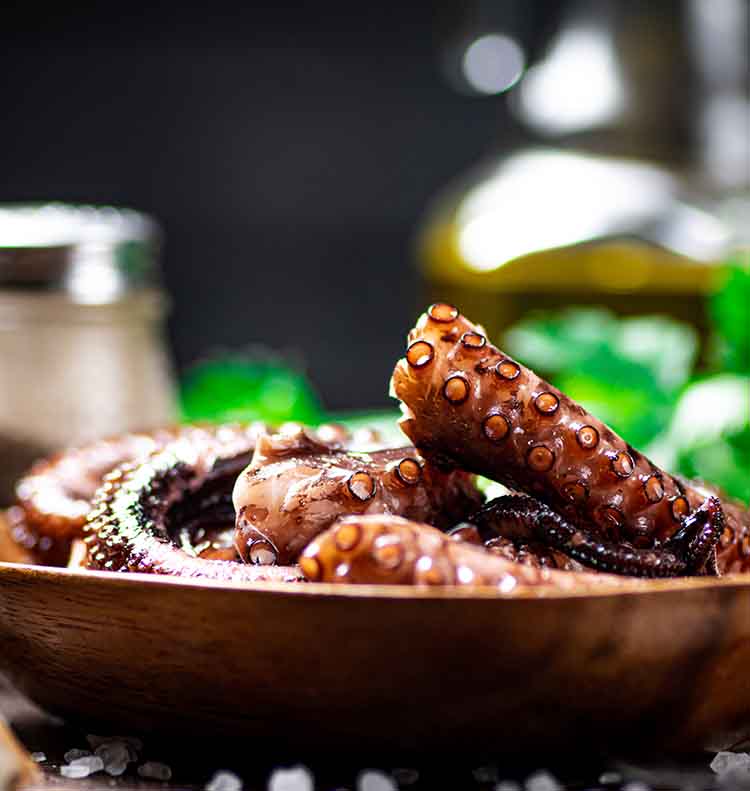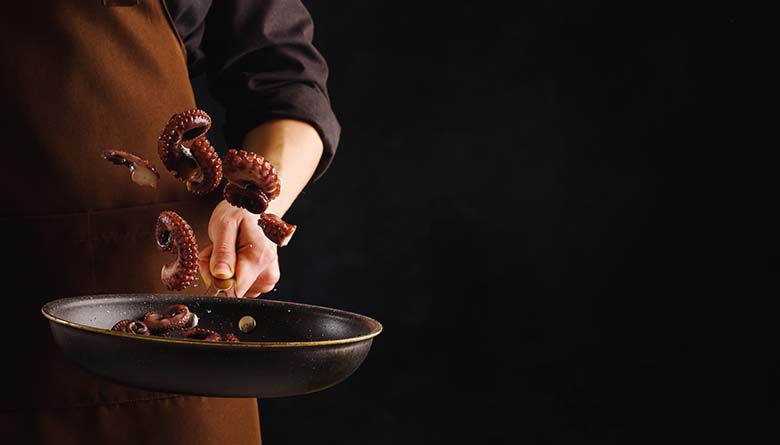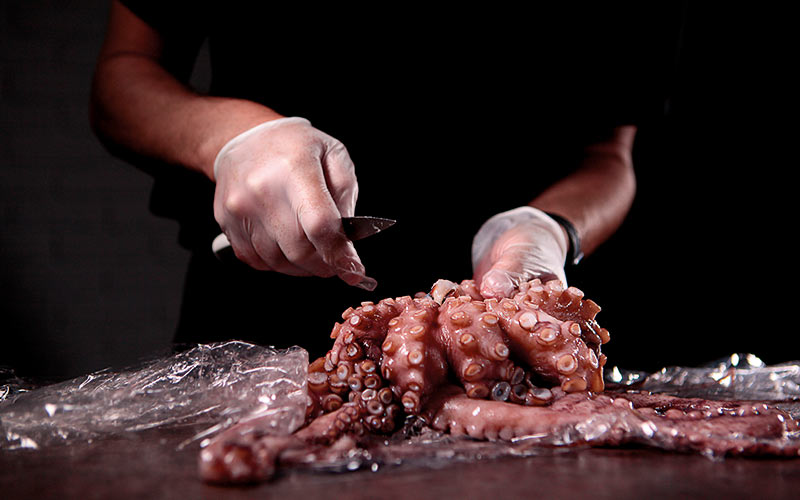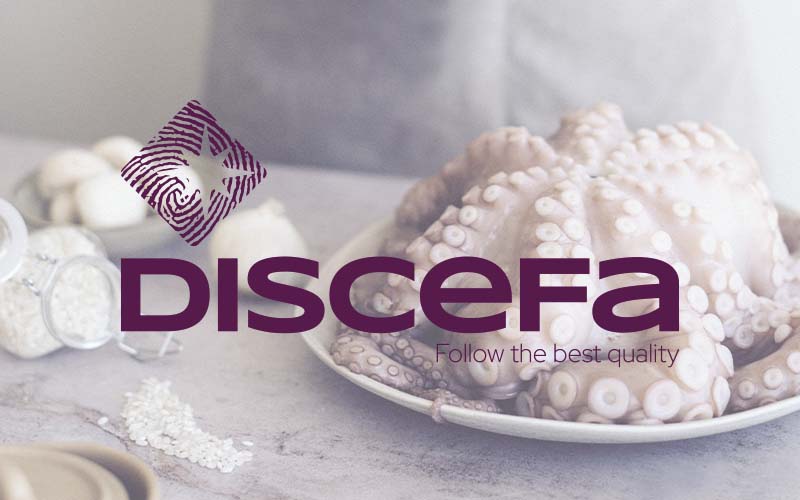I
n addition to being delicious, although at first glance it may not appear to be so, octopus contains minerals and vitamins very beneficial for our body.
It’s safe to eat octopus and among its properties, you can find: few hydrates, low caloric concentration, it satiates us easily, etc. These are some of the benefits of eating octopus:

Source of minerals
Octopus contains important minerals for our organism such as iodine, calcium, potassium, and several vitamins. With iodine, we can regulate cholesterol and process carbohydrates.
Another benefit is that it contains calcium, which helps protect and strengthen bones.
Source of Group B Vitamins
One serving of octopus provides you with:
- All the vitamin B12 you need in a day. This vitamin is required for our body to absorb iron and is therefore useful in case of anemia. Especially in diets low in meat, which is the other type of food that contain this vitamin in greater proportion.
- Half the niacin or vitamin B3 that you need in a day. This vitamin ensures that our body produces the necessary energy from food. At the same time, it contributes to the restoration of DNA. Therefore, it is a popular anticarcinogen.
- As it has a good part of vitamin B2, it helps reduce the levels of homocysteine found in the body, reducing the rates of strokes and other heart conditions.
- A quarter of vitamin B6 is needed in a day, an indispensable vitamin for the creation of antibodies, so it prevents diseases and infections. It also improves mood and some symptoms of premenstrual syndrome.
The octopus also has the rest of the vitamins of the B group, all of them characterized by their contribution to the well-being of the nervous system, improving concentration and mood.
Smooth skin
Little would you think that eating octopus is an advantage for our skin to be more smooth and shiny. Isn’t it wonderful? This is because it has a large amount of protein, and has iron and vitamin B.
Octopus as a Low-Fat, Low-Calorie Food:
Unlike other shellfish, octopus only has 48 mg of cholesterol, which makes it one of the best options in this regard. It also has less than a gram of fat per 100 grams of product, making it a very good choice to stay fit. All this without forgetting that it is low in calories, only 86 Kcal per 100gr.
Octopus is a great addition to any diet that seeks to be healthy. Its nutritional values are impressive and it is possible to preserve it in different ways. Also, its flavor, perhaps, is the strongest point of this amazing food.
How to clean the octopus correctly

Before consuming it, the first thing to do is to clean it properly. These are the best tips we can give you so that the octopus is ready to eat, without dirt or undesirable remains:
- Place the octopus under the tap and clean each of its corners. Make special emphasis on the tentacles, since this area hides particles and dirt. Clean the tentacles one by one. Although this is a laborious task, it is essential to enjoy a good quality octopus.
- Turn the octopus head upside down and remove the ink sac in the center. Make sure you do this in a large area that you can easily clean, such as the sink, as it is possible that the ink will stain the octopus.
- If you have purchased your octopus and the guts have not been removed, this is an essential step. Remove the beak and eyes with the help of a sharp knife or fishmonger’s scissors.
- Finally, run the octopus under running water to clean it completely.
You can ask the fishmonger to remove both the ink and the guts, which will considerably reduce the work involved in cleaning the octopus.
Tips for cooking octopus
Once this is done, it’s advisable to freeze the octopus for a minimum of 42 hours so that when it’s cooked it will have a perfect texture.
The freezing process causes the collagen fibres in the meat to break and as a result, you will get an octopus with juicy and very tender meat. You can also buy a deep-frozen octopus, which will come clean and ready to defrost and cook.
When cooking the octopus, bear in mind that the bigger it is, the longer cooking time it will need. You can take as an example, cooking time should b15 minutes for every 2 pounds of weight. Prior to cooking, it is essential that you put it in and take it out of the boiling water three times (in Spanish this process is called “asustar”). This is the perfect way for the octopus to maintain a nice shape after cooking. Some people prefer to flavor the water by adding bay leaves, parsley and onion.
You will be able to prepare a lot of great recipes, such as a delicious octopus salad with vinaigrette.
Please take a look at out post about how to cook octopus correctly.
Recipe: Easy Octopus salad with mustard vinaigrette

Nutritious, delicious and super easy to prepare, what are you waiting for to put it into practice!
Ingredients
For the salad
- 3 cooked octopus legs
- 1 roasted red bell pepper
- 1 Tomato
- 100 g of black olives
- 1 clove of garlic
- Lemon juice
- Salt
- Fresh parsley
For the vinaigrette
- 100 ml extra virgin olive oil
- 1 dash of white wine
- 1 tablespoon of mustard
- Salt
- Pepper
Directions
- Prepare the vinaigrette by mixing the ingredients with a whisk in a bowl.
- Chop the octopus, cut the bell pepper into strips and chop the tomato.
- Place in a salad bowl, add the finely chopped garlic, the olives and add the lemon juice, a pinch of salt and a pinch of pepper.
- Dress with the vinaigrette, let it sit in the refrigerator, sprinkle with chopped fresh parsley and it is ready to serve!
Just one last recommendation: You should always choose a quality octopus both when going to restaurants and in the supermarket.
Did you already know all the benefits and properties of octopus? Would you like to try it?
Related posts




